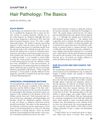Androgenetic Alopecia
September 2021
in “
CRC Press eBooks
”
TLDR Androgenetic alopecia is a common hair thinning condition linked to genetics and hormones.
Androgenetic alopecia (AGA) was described as an androgen-related hair disorder characterized by gradual and progressive follicular miniaturization, leading to patterned or diffuse thinning in genetically predisposed individuals. It was noted as the most common type of hair biopsy in daily practice, with most biopsies obtained from women. Men with classic AGA were rarely biopsied unless to exclude other conditions like focal lichen planopilaris or fibrosing alopecia in a pattern distribution, especially before hair transplant surgery. Trichoscopy was highlighted as a useful diagnostic tool for AGA, focusing on hair shaft variability, decreased number of hairs per follicular unit, increased single hairs, yellow dots, and the peripilar sign. These features helped in distinguishing AGA from other hair disorders.





